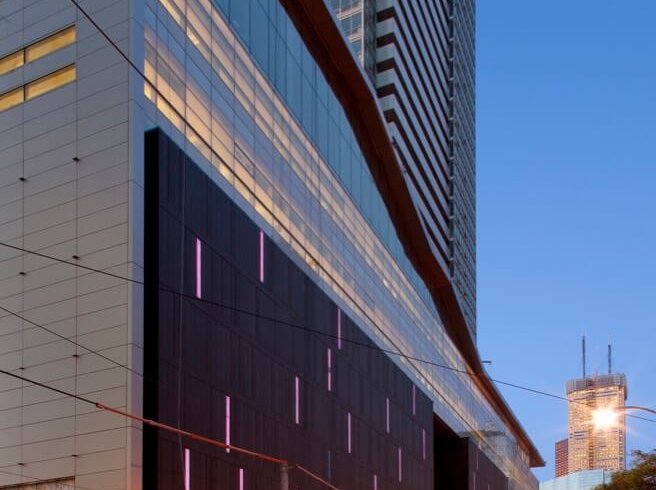During the brooding credit roll that opens Jean-Luc Godard’s Contempt, the narrator—Godard himself—quotes the critic Michel Mourlet: “The cinema,” he whispers, “substitutes for our gaze a world more in harmony with our desires.” Contempt, he adds, is the story of that world. Like much of Godard’s oeuvre, the film is a meditation on the history and nature of his art. Its meta-narrative, an adaptation of Homer’s Odyssey shot by legendary German expressionist Fritz Lang, frames a story about love’s bitter demise. At the end, the main character, a playwright-cum-screenwriter, clambers up a sweeping stairway to the rooftop of the Villa Malaparte, on the isle of Capri in Italy. There, Lang has his camera trained on Odysseus, who stands overlooking the Gulf of Salerno while Godard’s wide CinemaScope image slowly moves away from Lang, the actor, and the crew, settling on the glittering blue sea, the horizon, the sky. It is a suspended moment of pure, unadulterated cinema.
Come September, the scene will play a part in downtown Toronto, as an elaborate architectural conceit high up on the Toronto International Film Festival’s new tiff Bell Lightbox building. There, on the corner of King and John Streets, a dramatic staircase echoing the Villa Malaparte’s will rise from the southwestern corner of a spacious sixth-floor patio, with a view not of the Gulf of Salerno, alas, but of drab condominium high-rises. Still, a few months ago, when I found myself stumbling over construction equipment on top of the unfinished building with Piers Handling, director and ceo of tiff, and Bruce Kuwabara, the Lightbox’s lead architect, they were both giddy about the steps, like kids showing off the coolest part of their new fort.
The staircase, which led up to a shabby fence dividing the structure from the indoor swimming pool of the Festival Tower condominiums above, is essentially spectacle. Both Handling and Kuwabara were pleased that it had survived the inevitable budget tightening during construction. Despite the ubiquitous drywall dust and the frantic clamour, Handling was clearly already fantasizing about the glamorous movie stars who would pose there, embodying the world Mourlet described. “I told them to put planters up there,” the tiff director grumbled—condo developers don’t always have refined aesthetic taste.
I’d met up with Handling and Kuwabara in the developers’ makeshift headquarters, on the third floor of a former pub just behind the building. The room was plastered floor to ceiling with intricate plans scrawled over with notes. Taken together, the structurally intertwined Lightbox, Festival Tower, and below-ground parkade make for a seriously complicated project. But Handling and Kuwabara weren’t especially concerned with logistics; they’re big picture guys.
In his early sixties, Handling is a tall man with piercing eyes behind wire-rimmed glasses and a booming, authoritative voice. Kuwabara is slighter, intellectually intense, and evidently restless, with a quick-witted, mordant sense of humour. They bounced ideas off each other with the ease and fluidity of colleagues who have had their heads immersed in a landmark project for a long time, which they have: they’ve been working together since 2003, when Kuwabara and his firm, Kuwabara Payne McKenna Blumberg Architects, were awarded the contracts to design the Lightbox and the Festival Tower.
The complex marks tiff’s risky multimillion-dollar gambit to do what no other major Canadian cultural institution has managed to accomplish: create an authentically world-class, leading-edge centre. From its relatively simple origins in 1970s Toronto, tiff has evolved into far more than a ten-day annual film festival. Under its umbrella are the festival itself; tiff Cinematheque, one of the premier cinematheques in the world; the Film Reference Library; and Sprockets, a children’s film festival. Handling knew early on that he wanted to move his already complicated organization to a new level, and that doing so would involve giving it a permanent home. “I thought it would be a shame not to use the leverage the film festival’s success gave me,” he said. “We had some money put aside for research, so we commissioned a space-needs analysis for cinemas, a gallery, learning centres, and the like, and I took the board to Europe to see film museums in Berlin, London, Paris, and Lyons.” The result was the Lightbox, the only building of its kind in North America—a monumental centre devoted exclusively to the art of cinema.
Viewed from the outside, the Lightbox signifies cinema in all its historical complexity, from the grandeur of Cecil B. DeMille epics to the subtleties of recent European cinema. The ground floor is enclosed by vertical windows that sweep laterally around the corner from King West to John Street. The main entrance, tucked beneath a slightly pitched roof, unspools onto a massive central atrium and twin escalators to the second floor, where tiff’s star-studded galas will take place.
The exterior glass of the third, fourth, and fifth floors alternates between transparent and semi-transparent, creating a punctuated flow of horizontal strips that evoke moving lengths of celluloid. This pattern is interrupted in the building’s western quadrant by the dark, opaque cubes of two theatres that jut from their surroundings, seeming to float free. Set with vertical blue lights, these cubes do not so much expose formal structure (as one might expect in a high-modernist building) as assert that here the experience of cinema is primary, and that it is often private and introspective.
Adjacent to the bravura red carpet atrium will be a spacious gallery, which will provide insight into film and film history. “We’ve asked people over the years to donate archival material—we have a lot of stuff from David Cronenberg, like the props from Naked Lunch—but we’ve never had anyplace to put it,” Handling told me. This marriage of film and museum is extremely timely: increasingly, major international institutions are mounting exhibitions about the making of films. (The Tim Burton exhibit at the Museum of Modern Art in New York will travel to the Lightbox this fall.) And the boundary between film and the visual arts has lately broken open in a way unseen since the early twentieth century. Winnipeg filmmaker Guy Maddin has staged exhibits at places like the Power Plant in Toronto, for example, while painter Julian Schnabel and photographer Sam Taylor-Wood have both made acclaimed feature films in recent years.
The building’s state-of-the-art theatres occupy the second and third floors: one with 550 seats and a well for an orchestra, set up to screen both 3-D and 70-millimetre films; then others with 350, 250, 150, and 80 seats each. All are controlled from a central projection room, a cube that extends out into the main atrium. Hermetically sealed from the outside world, the theatres give tiff immense flexibility: programmers can have a live orchestra perform a score for Battleship Potemkin; screen 2001: A Space Odyssey in the 70 millimetre in which it was originally shot; show a Hollywood epic in 3-D; or simply present additional screenings of important films that command smaller audiences.
Kuwabara and his team at kpmb were a natural choice for the project, since they have been covering Toronto’s urban landscape with cultural institutions for years: in addition to the Lightbox, there is the Gardiner Museum, the Royal Conservatory, and the award-winning National Ballet School. Kuwabara’s work has a reputation for clarity, openness, and lightness of touch, eschewing showy ornament in favour of integration with the city. Indeed, even the Festival Tower seems subtle and elegant compared with the ugly, nearly identical glass and concrete complexes that litter Toronto’s harbourfront. kpmb insisted that its balconies be made of fritted glass, which, in addition to keeping furniture and bikes and laundry out of sight, will reflect the cityscape back to itself. Atop the tower will sit an immense light box, a beacon visible across the city.
“Architecture has to be both visionary and practical,” Kuwabara told me. “From the initial brief, you know what parts of the project have to be there, and what happens then is that a theme gets put forward and the architecture becomes a compelling narrative that drives the design. It will really be as though the city invades the building.” He added, “We the audience become the subject of the building. This is about coming into the building, seeing a great film, and stepping out and seeing the city.”
Kuwabara likes to speak of the Lightbox as a “city of cinema,” a metaphor borne out by the building’s mixture of urbane touches and translucent exterior. It both mirrors and melds with the city it is part of. The first-floor café, which will have outdoor tables, flows directly into the central atrium, while the second-floor restaurant opens onto a wide avenue that on one side spills off onto a seating area, and on the other forks toward the theatres. In one of the structure’s most spectacular gestures, the fifth-floor elevator bank leads onto a bridge over a second atrium, with light washing up from windows on the fourth floor and onto a wide, green-carpeted boulevard toward tiff’s magnificent open-concept office spaces, which look out on the city through a wall of windows that spans the length of the building. For Kuwabara, this should feel like a big city park. “I keep telling them they should get white lawn furniture,” he told me, laughing.
The idea throughout is to suggest cinema—specifically its hybrid of motion and vision. Moving through the building, whether circling the main atrium, or gliding along the panoramic windows of the tiff offices, or tracking down an interior corridor toward one of the theatres, one is always aware of the city outside streaming in. At night, the Lightbox will glow from the inside, its visitors appearing from the street below as silhouettes on a screen. For them, the only refuge from the light will be within the theatres themselves.
Handling took over the reins of tiff in 1994, after years as a film professor at Carleton and Queen’s universities, and then as a programmer for the Toronto festival. By then, it was already a prestigious event, serving as both a launching pad for new Canadian films and a nexus of global film culture. Under Handling’s direction, it has become the premier film festival in North America and arguably the world, presenting Academy Award–winning films such as American Beauty, and major works by significant and sometimes challenging international directors like Hungarian Béla Tarr and the Thai winner of this year’s Palme d’Or at Cannes, Apichatpong Weerasethakul. Handling’s success rests in part on his balance of seriousness and populism, on not alienating hard-core cineastes while bringing in ever-larger audiences and attracting corporate sponsors.
Most of the attendees swarming the red carpet events in the Lightbox’s atrium or the black-tie parties overlooking Toronto on the rooftop patio during the film festival this September probably won’t appreciate the allusion to Godard that so pleased Handling and Kuwabara. As a social phenomenon, the film festival can be a tad vapid: long ticket lines and packed theatres, roving media vans hunting for stray celebrities on Queen Street, patios congested with wannabe stars. The Lightbox is to an extent a way of lending tiff year-round presence and gravitas. Whether it succeeds will hinge upon the programming, events, and exhibitions that take place after the parties are over and the beautiful people have gone home. Chief responsibility for conceptualizing and overseeing these will go to the Lightbox’s artistic director, Noah Cowan.
“There’s always been a kind of recruitment subtext when we get people to come to the film festival galas,” Cowan told me. “We want them to delve deeper into other offerings and to get interested in the language of cinema, not unlike museum-goers who start with the Mona Lisa and move on to Pollock.” He added, “The Bell Lightbox needs to trigger loyalties. Just being a film museum would be too limiting, since it evokes dusty costumes; on the other hand, being just a movie theatre would be a failure as well, because film has gone way beyond that.” The main objective, according to Cowan, is to provide multiple access points for visitors, and to that end the Lightbox will offer “exhibitions, youth-based workshops, lectures for adults, interactions with filmmakers, and performances”—as well as great films.
Cowan pointed out that the Art Gallery of Ontario was widely perceived to have lost steam after its Frank Gehry redesign opened two years ago. He wants to keep the momentum created by the film festival going through the fall and beyond. The first major Lightbox initiative will be Essential Cinema, a showing of the top hundred films of all time as voted on by tiff’s in-house experts and other stakeholders. The idea combines the seriousness and populism Handling credits for the film festival’s success. Some acknowledged masterpieces will inevitably make the list, but there will also be films that might make rigorous cinephiles cringe. “Our larger strategic goal,” Cowan told me, “is to aggressively reinscribe film into the cultural world.”
The stairway above the Lightbox might be thought of as a metaphor for this vaulting ambition. From there, Handling looked out on the city as though he owned it, as though he were already in black tie, glass of champagne in hand. But Godard’s Contempt is an intensely ambivalent, melancholic film. By the time the filmmaker arrived on Capri, it was strewn with the ruined palaces of long-dead emperors, and the villa that housed the staircase had been abandoned for years. The success of the Lightbox, for all its uniqueness, is likewise far from assured. When I asked Handling what had inspired him, as a former academic and programmer, to undertake something this risky, and on this scale, he said, somewhat wistfully, “When I was younger, I looked to the British Film Institute and the Cinémathèque Française. It had always been a dream to create a space like that. We’re a big country, and we need a centre of excellence at home.”
This appeared in the September 2010 issue.




